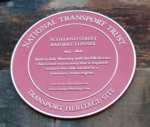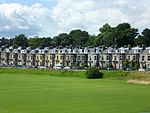Saint Stephen's Church is located in the New Town of Edinburgh, Scotland, at the bottom of Saint Vincent Street. It was built in 1827-1828, to a design by architect William Henry Playfair (1789–1857).
The first minister of the church was William Muir, who opened an evening school in the large vaulted cellars of the church for the education of the illiterate.
The interior was altered in 1956, the congregation having declined. A major fundraising effort was organised led by the then minister, the Revd A. Ian Dunlop. This was one of the first subdivisions of major buildings in Edinburgh, with the reconstructed church occupying effectively the gallery level accessed by the main staircase from Howe Street, and a number of halls (including a main hall with fully fitted stage etc.) and meeting rooms formed below. These halls have over the years hosted a number of events including Festival Fringe shows. During the reconstruction the church fittings by architect David Rhind (1808–1883) were kept, as was the organ by Willis, which was re-built on the "gallery" level.
On 27 June 2014, Leslie Benzies, a video game producer and at the time president of Rockstar North, announced a deal to purchase the church for over 500 thousand pounds. He plans to preserve the building and create a trust composed of members of the community to manage it.However, in 2017, Philip Johnston, trustee for the Benzies Foundation announced, "We now believe we have taken this as far as we can". On 12 July 2017, Peter Schaufuss, ballet dancer legend and founder of the English National Ballet School purchased the church from the Benzies Foundation, stating "I plan to make the Great Hall a world-class theatre, one that will attract productions from leading companies from around the world". Ground and basement areas, meanwhile, would be intended to find mixed commercial, cultural and community usage. Saint Stephens has since his take over gone through much refurbishment latest the main hall now named Ashton Hall with one of the largest performing spaces in Scotland. The building is the home of newly founded Edinburgh Festival Ballet and its School and the MGA Academy Scotlands premier theatre school, as well many other cultural activities. It plays an important role in the community as well as a legendary status as a venue at the annual Festival venue with its many attractive performing spaces. It is fast becoming the most thought after wedding venue in the capital and remain very much a landmark both architecturally externally and internally with its may important activities.








